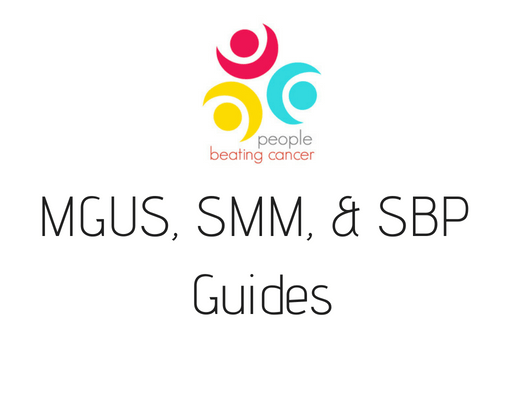
Diagnosed with Cancer? Your two greatest challenges are understanding cancer and understanding possible side effects from chemo and radiation. Knowledge is Power!
Learn about conventional, complementary, and integrative therapies.
Dealing with treatment side effects? Learn about evidence-based therapies to alleviate your symptoms.
Click the orange button to the right to learn more.
- You are here:
- Home »
- Blog »
- Pre-Myeloma »
- Smoldering Myeloma, TTP, Risk, Non-toxic Treatment
Smoldering Myeloma, TTP, Risk, Non-toxic Treatment

“…though they said their model was not able to accurately discriminate between patients with one or two risk factors during the first 2 to 3 years…”
Let’s be clear. A risk factor is just that. A risk, not a certainty. Increasing monoclonal proteins (MP) for the SMM patient may indicate risk of time to progression to MM. However, MP can decrease as well as increase. Non-toxic therapies can reduce the amount of MP in the patient’s bone marrow.
Based on the research linked and excerpted below certain risk factors can indicate shorter time to progression (TTP) for certain SMM patients. The challenge however, is that none of the risk factors is spot on 100% of the time.
Let’s say you’ve been diagnosed with SMM. Let’s also say that certain markers in the study below indicate that you have a greater chance of progression to MM. You are “high risk” SMM.
Unfortunately, your oncologist can’t say that your high risk SMM is guaranteed to progress to MM. It probably will but we can’t be certain.
And let’s also say that you’ve read about SMM survivors remaining in their pre-MM state. For years, these SMM survivors have NOT progressed.
What do you do? Do you undergo evidence-based non-toxic therapies such as curcumin, omega-3 fatty acids, anti-angiogenic foods, sauna a few time a week- all in hopes of remaining SMM. Or do you undergo chemotherapy shown to increase your TTP. No, chemo will not increase your overall survival and you will definitely feel the usual side effects.
But studies do document that your time to progression is longer with chemo. But then again, research supported by experience indicates that SMM patients may not progress to MM.
What do you do?
To learn more about evidence-based, non-toxic therapies to reduce your risk of multiple myeloma, scroll down the page, send me a question or comment and I will reply to you ASAP.
Thanks,
David Emerson
- MM Survivor
- MM Cancer Coach
- Director PeopleBeatingCancer
Recommended Reading-
Exploring Biomarker-Based Risk Stratification in Smoldering Multiple Myeloma
As methods continue to evolve for how best to identify patients with smoldering multiple myeloma (SMM) who are at risk of progression, a new retrospective analysis suggests that dynamic changes in monoclonal protein (MP) can be an effective identifier of progression risk.
The report also affirms that the percentage of bone marrow plasma cells (BMPC) at diagnosis and the relative increase of involved free light chain (eiFLC) could be significant predictors of progression at follow-up…
Corresponding author Charlotte Gran, MD, and colleagues noted that several different models have been suggested to risk-stratify patients with SMM. First, the Mayo Clinic unveiled a prediction score that defined MP>30g/L and BMPC>10% as independent risk factors (RFs) for progression to MM within 5 years.
In 2014, the International Myeloma Working Group issued guidance classifying the risk factors BMPCs>60%, FLC ratio>100 as myeloma defining events, rather than ultra high-risk SMM…
Some reports have indicated that cumulative increase of MP during follow-up is an RF for SMM, and at least one study has shown that an increase of iFLC is a risk factor, though Gran and colleagues said FLC assessments are method-dependent, making it difficult to make comparisons.
In an effort to provide clarity to the situation, Gran and colleagues conducted a retrospective study assessing 126 SMM, 44 of whom progressed to MM, and 82 of whom did not). The investigators assessed patient biomarkers, with a median follow-up of 4.5 years. MP and FLC were assessed every 2 months, and the investigators then stratified patients according to previously published risk prediction models.
Their analysis showed that MP>20g/L at diagnosis was in fact an independent RF for progression, as was BMPC>20%. Further analysis showed that FLCr>8 was the optimal cut-off when stratifying patients, but they said it was not an independent RF.
Gran and colleagues found the median time to progression (TTP) was significant shorter in patients who met the two independent risk factors, though they said their model was not able to accurately discriminate between patients with one or two risk factors during the first 2 to 3 years, possibly because RFs at diagnosis do not account for the impact of evolving RFs.
Ten total patients (8%) died without evidence or progression, with a median follow-up of 25 months. Two patients were lost to follow-up.
The authors also identified two independent dynamic RFs using multivariate cox regression: evolving MP>5g/L and evolving FLCr>4.5. Those with either RF were classified in the analysis as high risk, and those patients had significantly shorter median TTPs compared with the low-risk patients.
Gran and co-authors noted that nailing down a meaningful risk profile is important because treatment of patients with high-risk SMM has been shown to increase both TTP and overall survival.
The investigators concluded by noting that their findings are exploratory in nature, and thus would need to be confirmed in larger studies. However, they said their data support MP and BMPC as valid predictors of risk at diagnosis, and evolving MP and FLCr as valid biomarkers at follow-up.
“With a median TTP of 5 months after an evolving pattern is observed, patients with evolving RF should be closely monitored,” they wrote.
Reference
Gran C, Luong, V, Bruchfeld JB, et al.Dynamic follow‐up of smoldering multiple myeloma identifies a subset of patients at high risk of progression. Am J Hematol. Published online December 2, 2020. doi: 10.1002/ajh.26062



